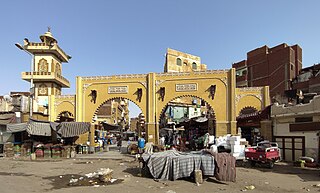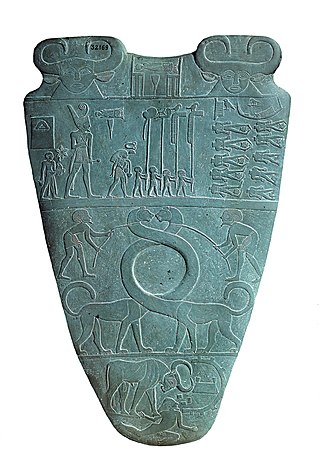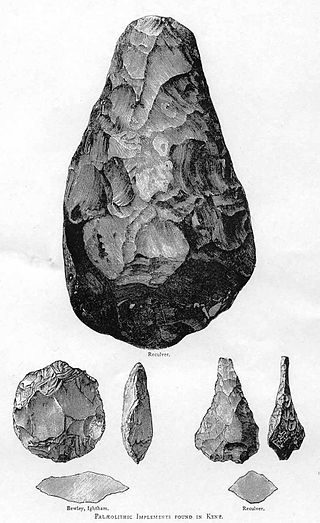Related Research Articles

Aswan is a city in Southern Egypt, and is the capital of the Aswan Governorate.

Wadjet, known to the Greek world as Uto or Buto among other renderings including Wedjat, Uadjet, and Udjo, was originally the ancient Egyptian local goddess of the city of Dep or Buto in Lower Egypt, which was an important site in prehistoric Egypt.

Kom Ombo (Egyptian Arabic: كوم أمبو; Coptic: ⲙ̄ⲃⲱəmbō or ⲛ̄ⲃⲱənbō; Ancient Greek: ὌμβοιOmboi or ὌμβοςOmbos; or Latin: Ambo and Ombi is an agricultural town in Egypt famous for the Temple of Kom Ombo. It was originally an Egyptian city called Nubt, meaning City of Gold. Nubt is also known as Nubet or Nubyt. It became a Greek settlement during the Greco-Roman Period. The town's location on the Nile, 50 kilometres north of Aswan, gave it some control over trade routes from Nubia to the Nile Valley, but its main rise to prominence came with the erection of the Temple of Kom Ombo in the 2nd century BC.
Nubians are a Nilo-Saharan ethnic group indigenous to the region which is now Northern Sudan and Southern Egypt. They originate from the early inhabitants of the central Nile valley, believed to be one of the earliest cradles of civilization. In the southern valley of Egypt, Nubians differ culturally and ethnically from Egyptians, although they intermarried with members of other ethnic groups, especially Arabs. They speak Nubian languages as a mother tongue, part of the Northern Eastern Sudanic languages, and Arabic as a second language.

Wādī Ḥalfā is a city in the Northern state of Sudan on the shores of Lake Nubia near the border with Egypt. It is the terminus of a rail line from Khartoum and the point where goods are transferred from rail to ferries going down the lake. As of 2007, the city had a population of 15,725. The city is located amidst numerous ancient Nubian antiquities and was the focus of much archaeological work by teams seeking to save artifacts from the flooding caused by the completion of the Aswan Dam.

Naucratis or Naukratis was a city and trading-post in ancient Egypt, located on the Canopic (western-most) branch of the Nile river, south-east of the Mediterranean sea and the city of Alexandria. Naucratis was the first and, for much of its early history, the only permanent Greek settlement in Egypt, serving as a symbiotic nexus for the interchange of Greek and Egyptian art and culture.

Prehistoric Egypt and Predynastic Egypt span the period from the earliest human settlement to the beginning of the Early Dynastic Period around 3100 BC, starting with the first Pharaoh, Narmer for some Egyptologists, Hor-Aha for others, with the name Menes also possibly used for one of these kings.

The Kerma culture or Kerma kingdom was an early civilization centered in Kerma, Sudan. It flourished from around 2500 BC to 1500 BC in ancient Nubia. The Kerma culture was based in the southern part of Nubia, or "Upper Nubia", and later extended its reach northward into Lower Nubia and the border of Egypt. The polity seems to have been one of a number of Nile Valley states during the Middle Kingdom of Egypt. In the Kingdom of Kerma's latest phase, lasting from about 1700 to 1500 BC, it absorbed the Sudanese kingdom of Sai and became a sizable, populous empire rivaling Egypt. Around 1500 BC, it was absorbed into the New Kingdom of Egypt, but rebellions continued for centuries. By the eleventh century BC, the more-Egyptianized Kingdom of Kush emerged, possibly from Kerma, and regained the region's independence from Egypt.
Uan Muhuggiag is an archaeological site in Libya that was occupied by pastoralists between the early Holocene and mid-Holocene; the Tashwinat mummy, which was found at Uan Muhuggiag, was dated to 5600 BP and presently resides in the Assaraya Alhamra Museum in Tripoli.

Naqada III is the last phase of the Naqada culture of ancient Egyptian prehistory, dating from approximately 3200 to 3000 BC. It is the period during which the process of state formation, which began in Naqada II, became highly visible, with named kings heading powerful polities. Naqada III is often referred to as Dynasty 0 or the Protodynastic Period to reflect the presence of kings at the head of influential states, although, in fact, the kings involved would not have been a part of a dynasty. In this period, those kings' names were inscribed in the form of serekhs on a variety of surfaces including pottery and tombs.
The Halfan industry is one of the Late Epipalaeolithic industries of the Upper Nile Valley that seems to have appeared in northern Sudan c. 22.5-22.0 ka cal BP. It is one of the earliest known backed-bladelet industries in Northern Africa, dating between 22.5 and 16 ka cal BP in Nubia. The Halfan is restricted to the north of Sudan, its Egyptian counterpart, which is in all respects similar, is known as the Kubbaniyan.

Nubia is a region along the Nile river encompassing the area between the first cataract of the Nile and the confluence of the Blue and White Niles, or more strictly, Al Dabbah. It was the seat of one of the earliest civilizations of ancient Africa, the Kerma culture, which lasted from around 2500 BC until its conquest by the New Kingdom of Egypt under Pharaoh Thutmose I around 1500 BC, whose heirs ruled most of Nubia for the next 400 years. Nubia was home to several empires, most prominently the Kingdom of Kush, which conquered Egypt in the eighth century BC during the reign of Piye and ruled the country as its 25th Dynasty.

The following outline is provided as an overview of a topical guide to ancient Egypt:

Abu Simbel is a village in the Egyptian part of Nubia, about 240 km (150 mi) southwest of Aswan and near the border with Sudan. As of 2012, it has about 2600 inhabitants. It is best known as the site of the Abu Simbel temples, which were built by King Ramses II.

The Mushabian culture is an archaeological culture suggested to have originated among the Iberomaurusians in North Africa, though once thought to have originated in the Levant.

The civilization of ancient Egypt was indebted to the Nile River and its dependable seasonal flooding. The river's predictability and fertile soil allowed the Egyptians to build an empire on the basis of great agricultural wealth. Egyptians are credited as being one of the first groups of people to practice agriculture on a large scale. This was possible because of the ingenuity of the Egyptians as they developed basin irrigation. Their farming practices allowed them to grow staple food crops, especially grains such as wheat and barley, and industrial crops, such as flax and papyrus.

Dishna (Arabic: دشنا, from Coptic: ⲧⲉϣⲛⲏ, lit. 'the tree garden') is an Egyptian settlement west of Qena situated on the north bank of the river Nile.

The following outline is provided as an overview of and topical guide to prehistoric technology.
Edward Bruce (Ted) Banning is a Canadian archaeologist and professor at the University of Toronto. He was born in Montreal in 1955 but has lived in Toronto for most of his life. His research focuses on the beginnings of village life and political-economic inequality in southwest Asia, especially in the Neolithic, and concentrates on the southern Levant. He has also been very involved in theoretical and methodological research on archaeological survey.
Wadi Kubbaniya is a Late Paleolithic site in Upper Egypt. Archaeologists initially believed that the site held evidence for some of the earliest examples of agriculture. When Wadi Kubbaniya was discovered, there were traces of barley that were originally thought to be evidence of farming. The belief now is that this is most likely not the case. The site has been dated to between 19,000 and 17,000 years ago using radiocarbon dating. This site was a part of a settlement system that people would come back to during its prime seasons of summer and winter.
References
- ↑ "Introduction to Ancient Egypt | World Civilizations I (HIS101) – Biel". courses.lumenlearning.com. Retrieved 2023-12-17.
- ↑ Béatrix Midant-Reynes The prehistory of Egypt from the first Egyptians to the first pharaohs - 328 pages Wiley-Blackwell, 28 Feb 2000 Retrieved 2012-01-10 ISBN 0-631-21787-8
- ↑ Ian Shaw, Robert Jameson A dictionary of archaeology. Wiley-Blackwell, 2002. 6 May 2002. ISBN 9780631235835 . Retrieved 2012-01-10. ISBN 0-631-23583-3
- 1 2 Karl W. Butzer Environment and archeology: an ecological approach to prehistory. Taylor & Francis, 1972 - 703 pages. 1972. ISBN 9780416675009 . Retrieved 2012-01-10. ISBN 0-416-67500-X
- 1 2 page 160 of Butzer Karl W. Butzer, Karl W. (1997). "Late Quaternary problems of the Egyptian Nile : stratigraphy, environments, prehistory". Paléorient. Paléorient. 1997, Vol. 23 N°2. Paléoenvironnement et sociétés humaines au moyen-orient de 20 000 BP à 6 000 BP. pp. 151-173. 23 (2): 151–173. doi:10.3406/paleo.1997.4658 . Retrieved 2012-01-14.
- 1 2 Michael A. Hoffman Egypt before the pharaohs: the prehistoric foundations of Egyptian civilization. Taylor & Francis, 1980. 1980. ISBN 0-7100-0495-8 . Retrieved 2012-01-10.
- ↑ PEL Smith - 2009 "New Prehistoric Investigations at Kom Ombo (Upper Egypt)" (PDF). University of Montreal. Retrieved 2012-01-10.
- ↑ Langer, William L., ed. (1972). An Encyclopedia of World History (5th ed.). Boston, MA: Houghton Mifflin Company. pp. 9. ISBN 0-395-13592-3.